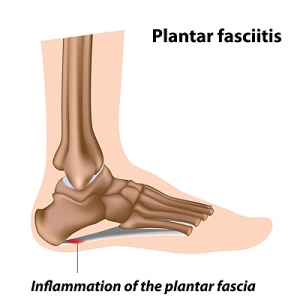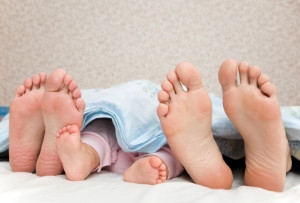Connect With Us

Can Wearing High Heels Damage My Feet?
 Many women choose to wear high heels so the feet and legs can have a luxurious look. Research has shown there may be reasons why high heels should be avoided. Toenails can become damaged, and wearing certain high heels is said to be the number one cause of ingrown toenails. Many women tend to fall much more frequently when this type of shoe is worn, and this may cause possible bone fractures. If there is not an adequate amount of room to move about within the shoe, it can cause an already existing case of bunions to become even worse. It’s suggested to limit wearing high heels to a few days per week, and to also choose a lower heel. Doing these things may provide ample relief. Additionally, having your feet massaged regularly will not only feel good, but may aid in the overall health of the foot.
Many women choose to wear high heels so the feet and legs can have a luxurious look. Research has shown there may be reasons why high heels should be avoided. Toenails can become damaged, and wearing certain high heels is said to be the number one cause of ingrown toenails. Many women tend to fall much more frequently when this type of shoe is worn, and this may cause possible bone fractures. If there is not an adequate amount of room to move about within the shoe, it can cause an already existing case of bunions to become even worse. It’s suggested to limit wearing high heels to a few days per week, and to also choose a lower heel. Doing these things may provide ample relief. Additionally, having your feet massaged regularly will not only feel good, but may aid in the overall health of the foot.
High heels have a history of causing foot and ankle problems. If you have any concerns about your feet or ankles, contact Dr. Richard Silverstein from Union Foot Care. Our doctor can provide the care you need to keep you pain-free and on your feet.
Effects of High Heels on the Feet
High heels are popular shoes among women because of their many styles and societal appeal. Despite this, high heels can still cause many health problems if worn too frequently.
Which Parts of My Body Will Be Affected by High Heels?
- Ankle Joints
- Achilles Tendon – May shorten and stiffen with prolonged wear
- Balls of the Feet
- Knees – Heels cause the knees to bend constantly, creating stress on them
- Back – They decrease the spine’s ability to absorb shock, which may lead to back pain. The vertebrae of the lower back may compress.
What Kinds of Foot Problems Can Develop from Wearing High Heels?
- Corns
- Calluses
- Hammertoe
- Bunions
- Morton’s Neuroma
- Plantar Fasciitis
How Can I Still Wear High Heels and Maintain Foot Health?
If you want to wear high heeled shoes, make sure that you are not wearing them every day, as this will help prevent long term physical problems. Try wearing thicker heels as opposed to stilettos to distribute weight more evenly across the feet. Always make sure you are wearing the proper shoes for the right occasion, such as sneakers for exercising. If you walk to work, try carrying your heels with you and changing into them once you arrive at work. Adding inserts to your heels can help cushion your feet and absorb shock. Full foot inserts or metatarsal pads are available.
If you have any questions please feel free to contact our office located in Havre de Grace, MD . We offer the newest diagnostic and treatment technologies for all your foot and ankle needs.
Effect of High Heels on the Feet
For hundreds of years, women have been wearing various kinds of high heels for aesthetic reasons. Women who wear high heels appear to be taller and have longer and thinner legs, and the wearer’s gait and posture changes. Though high heels have had an association with femininity and have kept them popular over the years, there are definite health problems caused by wearing them too frequently.
The motion of the ankle joints is limited when heels are worn. The ankle joint is very important to the body when it comes to walking. Because of their location, these joints have a great deal of weight put on them. Thus, it is very important to keep them as healthy as possible. The Achilles tendon is the main tendon in the ankle. Wearing high heels too often, studies have shown, can cause the calf muscle and Achilles tendon to shorten and stiffen. This can cause problems when shoes without heels are worn.
By putting a great deal of pressure on the ball of the foot and by forcing the toes into a small toe box, high heels can cause or may worsen many foot problems. These include corns, hammertoe, bunions, Morton’s neuroma and plantar fasciitis.
Not only does wearing high heels regularly have negative effects on the feet, the rest of the body can suffer as well. The knees, one of the most important joints in the entire body, can be affected by wearing high heels. High heels can cause the knees to stay bent all the time. Also, it can cause them to bend slightly inward as well. Doctors believe that women can suffer from osteoarthritis later in life because of constantly walking like in high heels. By limiting the natural motion of the foot during walking, high heels also cause an increased in stress on the knees.
Similarly, high heels can cause the back to go out of alignment. If high heels are worn constantly, the spine’s ability to absorb shock can cause continued back pain. They can compress the vertebrae of the lower back, and can overuse the back muscles.
However, this is not to say that high heels can never be worn. If worn occasionally and not often, they will not cause serious problems. They should not be worn every day. It’s important to wear them modestly to avoid the long-term physical health problems of the feet, knees, ankles, and back mentioned above.
Who is Susceptible to Developing Plantar Fasciitis?
 The most common cause of heel pain may be a condition that is referred to as plantar fasciitis. It occurs when the thick ligament that connects the heel to the front of the foot becomes inflamed. It’s purpose is to aid in walking, in addition to supporting the arch. Some of the symptoms that many patients experience is heel pain and moderate to severe stiffness, which may make walking up and down the steps difficult. This condition may affect people from all walks of life, and more specifically runners, women in late pregnancy, and those who are overweight. Additionally, this ailment may be caused by inherited traits, which may play a role in altering the structure of the foot. If you feel you may be afflicted with plantar fasciitis, it’s important that you contact a podiatrist as quickly as possible who can advise what the best possible treatment options are for you.
The most common cause of heel pain may be a condition that is referred to as plantar fasciitis. It occurs when the thick ligament that connects the heel to the front of the foot becomes inflamed. It’s purpose is to aid in walking, in addition to supporting the arch. Some of the symptoms that many patients experience is heel pain and moderate to severe stiffness, which may make walking up and down the steps difficult. This condition may affect people from all walks of life, and more specifically runners, women in late pregnancy, and those who are overweight. Additionally, this ailment may be caused by inherited traits, which may play a role in altering the structure of the foot. If you feel you may be afflicted with plantar fasciitis, it’s important that you contact a podiatrist as quickly as possible who can advise what the best possible treatment options are for you.
Plantar fasciitis is a common foot condition that is often caused by a strain injury. If you are experiencing heel pain or symptoms of plantar fasciitis, contact Dr. Richard Silverstein from Union Foot Care. Our doctor can provide the care you need to keep you pain-free and on your feet.
What Is Plantar Fasciitis?
Plantar fasciitis is one of the most common causes of heel pain. The plantar fascia is a ligament that connects your heel to the front of your foot. When this ligament becomes inflamed, plantar fasciitis is the result. If you have plantar fasciitis you will have a stabbing pain that usually occurs with your first steps in the morning. As the day progresses and you walk around more, this pain will start to disappear, but it will return after long periods of standing or sitting.
What Causes Plantar Fasciitis?
- Excessive running
- Having high arches in your feet
- Other foot issues such as flat feet
- Pregnancy (due to the sudden weight gain)
- Being on your feet very often
There are some risk factors that may make you more likely to develop plantar fasciitis compared to others. The condition most commonly affects adults between the ages of 40 and 60. It also tends to affect people who are obese because the extra pounds result in extra stress being placed on the plantar fascia.
Prevention
- Take good care of your feet – Wear shoes that have good arch support and heel cushioning.
- Maintain a healthy weight
- If you are a runner, alternate running with other sports that won’t cause heel pain
There are a variety of treatment options available for plantar fasciitis along with the pain that accompanies it. Additionally, physical therapy is a very important component in the treatment process. It is important that you meet with your podiatrist to determine which treatment option is best for you.
If you have any questions, please feel free to contact our office located in Havre de Grace, MD . We offer the newest diagnostic and treatment technologies for all your foot care needs.
Plantar Fasciitis
The plantar fascia is a connective tissue in the heel that stretches across the bottom length of your foot. Plantar fasciitis occurs when the connective tissue becomes inflamed, causing heel pain and discomfort during physical activity. Although the condition is completely treatable, traditional methods can take up to a year to start becoming effective.
Plantar fasciitis is caused by a number of everyday activities, so understanding the condition is important for managing and treating it. One of the most common causes of plantar fasciitis is excessive running, especially with improper fitting or non-supportive shoes. Too much exercise can lead to the plantar fascia being overworked and overstretched, which can cause tears in the tissue. Along with improper fitting shoes, pronation, the rolling of the feet inward, is a common cause of plantar fasciitis. If not treated properly, the plantar fascia becomes overstretched and starts to tear, causing inflammation.
Despite the common causes of plantar fasciitis, there are many different treatment options. For less severe cases, conservative home remedies include taking anti-inflammatory drugs to alleviate pain, applying ice packs to the bottom of your foot and heel, slowly stretching and exercising your feet to re-strengthen the tissue, and using orthotic devices are all ways to help manage your plantar fasciitis.
For more severe cases, shockwave therapy has become a common solution for plantar fasciitis. Shockwave therapy can effectively break up the tissue on the bottom of your foot which facilitates healing and regeneration. This fights the chronic pain caused by plantar fasciitis. Even if this doesn’t work, surgery is always a final option. Surgery on the tissue itself can be done to permanently correct the issue and stop the inflammation and pain in your heels.
No matter what the case may be, consulting your podiatrist is the first and best step to recovery. Even the slightest amount of heel pain could be the first stage of plantar fasciitis. Untreated symptoms can lead to the tearing and overstretching of tissue. Because the tearing of tissue can be compounded if it remains ignored, it can evolve into a severe case. The solution is early detection and early treatment. Talk to your podiatrist about the possibilities of plantar fasciitis if you’re experiencing heel pain.
Are Ingrown Toenails Painful?
 Increased pressure of a toenail that grows into the surrounding skin is often referred to as an ingrown toenail. This condition can often produce severe discomfort and pain as a result of inflammation that may occur. If this ailment is left untreated, infections can occur, which may lead to additional unwanted foot conditions. Typical reasons why ingrown toenails can develop, may include having a pedicure performed incorrectly, traits from inherited genes, or shoes that do not fit correctly. Medical conditions such as obesity, diabetes, bunions, or hammertoes may play a significant role in developing this painful condition. If you are afflicted with an ingrown toenail, it’s advised to seek a consultation with a podiatrist as quickly as possible to learn about correct treatment options.
Increased pressure of a toenail that grows into the surrounding skin is often referred to as an ingrown toenail. This condition can often produce severe discomfort and pain as a result of inflammation that may occur. If this ailment is left untreated, infections can occur, which may lead to additional unwanted foot conditions. Typical reasons why ingrown toenails can develop, may include having a pedicure performed incorrectly, traits from inherited genes, or shoes that do not fit correctly. Medical conditions such as obesity, diabetes, bunions, or hammertoes may play a significant role in developing this painful condition. If you are afflicted with an ingrown toenail, it’s advised to seek a consultation with a podiatrist as quickly as possible to learn about correct treatment options.
Ingrown toenails may initially present themselves as a minor discomfort, but they may progress into an infection in the skin without proper treatment. For more information about ingrown toenails, contact Dr. Richard Silverstein of Union Foot Care. Our doctor can provide the care you need to keep you pain-free and on your feet.
Ingrown Toenails
Ingrown toenails are caused when the corner or side of a toenail grows into the soft flesh surrounding it. They often result in redness, swelling, pain, and in some cases, infection. This condition typically affects the big toe and may recur if it is not treated properly.
Causes
- Improper toenail trimming
- Genetics
- Improper shoe fitting
- Injury from pedicures or nail picking
- Abnormal gait
- Poor hygiene
You are more likely to develop an ingrown toenail if you are obese, have diabetes, arthritis, or have any fungal infection in your nails. Additionally, people who have foot or toe deformities are at a higher risk of developing an ingrown toenail.
Symptoms
Some symptoms of ingrown toenails are redness, swelling, and pain. In rare cases, there may be a yellowish drainage coming from the nail.
Treatment
Ignoring an ingrown toenail can have serious complications. Infections of the nail border can progress to a deeper soft-tissue infection, which can then turn into a bone infection. You should always speak with your podiatrist if you suspect you have an ingrown toenail, especially if you have diabetes or poor circulation.
If you have any questions, please feel free to contact our office located in Havre de Grace, MD . We offer the newest diagnostic and treatment technologies for all your foot care needs.
Ingrown Toenail Care
An ingrown toenail is a toenail that grows sideways into the nail bed, causing pain and swelling. Ingrown toenails can worsen and cause drainage, turning into a serious infection.
Several factors affect whether a person is at risk from an ingrown toenail. The many causes include being overweight, diabetes, participating in sports, having a fungal infection of the toe, and cutting your nails too short. Ingrown toenails also have a genetic predisposition, causing some people to be more prone to receive the condition than others. Other causes include improperly fitting shoes and shoes that keep the feet damp.
Ingrown toenails can be preventable with certain measures. For starters, allowing your toe nails to grow slightly longer in length will help prevent them from becoming ingrown. If you have already developed an ingrown toenail, soak the affected toe in warm water. This will alleviate the pain and help prevent an infection from forming. Antibiotic soap or Epsom salts may be added to further help the relieving process and avoid infection. Placing cotton beneath the affected area is also suggested, as this may help the toenail grow upwards and not into the nail bed. Swelling and redness can be reduced by resting with your feet elevated.
A podiatrist should be seen if the pain becomes so serious that it prevents you from doing your everyday activities. If a red streak running up your leg appears or if you suspect your infection has spread, contact a podiatrist immediately. Fast treatments can be undertaken to lessen your pain and have you walking comfortably.
An ingrown toenail can be easily treated with a Band-Aid. Simply wrap the affected toe with a Band-Aid to prevent infection and keep the nail from growing out at a painful angle.
In more serious cases, your podiatrist may decide to make a small incision to remove a portion of your toenail. To prevent the nail from growing back, medication will be placed directly into the nail bed. This procedure would be performed under local anesthesia and is a faster method to alleviate discomfort from an ingrown toenail. Post-procedure directions will have you stay off the affected foot for a day. Afterwards, normal activities can be resumed.
Why Should Children’s Feet Be Measured Frequently?
 Recent research has shown the importance of children walking barefoot or wearing shoes that have a soft sole when they are beginning to walk. This will enable the development of necessary muscle strength in addition to learning sensory information that originates from the soles of the feet. The feet should be properly measured once walking commences, to ensure a proper fit for shoes. Children’s feet grow rapidly, and frequent measuring of the feet will aid in choosing shoes that fit correctly. Foot conditions may develop as a result of poorly fitting shoes. These may include ingrown toenails, blisters, or the inability to walk correctly. When shopping for shoes, it’s important for the toes to have adequate room to move around and the front of the shoe should be wider than the heel. Most children are born with flat feet and arches will form when walking begins. Please consult with a podiatrist if your child appears to be flat-footed once walking has started.
Recent research has shown the importance of children walking barefoot or wearing shoes that have a soft sole when they are beginning to walk. This will enable the development of necessary muscle strength in addition to learning sensory information that originates from the soles of the feet. The feet should be properly measured once walking commences, to ensure a proper fit for shoes. Children’s feet grow rapidly, and frequent measuring of the feet will aid in choosing shoes that fit correctly. Foot conditions may develop as a result of poorly fitting shoes. These may include ingrown toenails, blisters, or the inability to walk correctly. When shopping for shoes, it’s important for the toes to have adequate room to move around and the front of the shoe should be wider than the heel. Most children are born with flat feet and arches will form when walking begins. Please consult with a podiatrist if your child appears to be flat-footed once walking has started.
The health of a child’s feet is vital to their overall well-being. If you have any questions regarding foot health, contact Dr. Richard Silverstein of Union Foot Care. Our doctor can provide the care you need to keep you pain-free and on your feet.
Tips for Keeping Children's Feet Healthy
- Make sure their shoes fit properly
- Look for any signs of in-toeing or out-toeing
- Check to see if they have Clubfoot (condition that affects your child’s foot and ankle, twisting the heel and toes inward) which is one of the most common nonmajor birth defects.
- Lightly cover your baby’s feet (Tight covers may keep your baby from moving their feet freely, and could prevent normal development)
- Allow your toddler to go shoeless (Shoes can be restricting for a young child’s foot)
- Cut toenails straight across to avoid ingrown toenails
- Keep your child’s foot clean and dry
- Cover cuts and scrapes. Wash any scratches with soap and water and cover them with a bandage until they’ve healed.
If you have any questions, please feel free to contact our office located in Havre de Grace, MD . We offer the newest diagnostic and treatment technologies for all your foot care needs.
What to Do to Keep Your Child’s Feet Healthy
Being a parent involves caring for your child in every way you can. You make sure they are eating the right food, being nice to others, and staying out of any trouble. However, it is also important that you are watchful of their health, more specifically their foot health. Maintaining good foot health in childhood is important in preventing later conditions in life from happening. As children continue to develop, their feet require different techniques of care. Here are some various ways in which you can help your child’s feet stay healthy.
A baby needs a lot of care and attention overall, but the importance of their feet should never be forgotten. Before a baby turns one, their feet change and develop greatly. It is important that during this time, a mother avoids putting tight socks on their child. She should also encourage movement of their feet so the baby can begin to feel more comfortable using them.
As a baby enters the toddler years of his or her life, they are begin to walk around. When your baby begins to take those first steps, it is crucial that they are wearing protective shoes on their feet. As a mother that is observant of your child’s feet, you may notice changes in them. This is completely normal as the feet are becoming susceptible to the activity of walking. It is normal for a toddler to be a bit unsteady or to “walk funny” at first.
When your child grows out of their toddler years, it is important that you begin to show him or her how to care for their feet on their own. Practice with your child proper hygiene in order to prevent foot fungus or infection. Since children are constantly on the move, it is crucial to be cautious of any accidents or injuries that might occur. If an injury occurs, it is advised that you take your child to be examined by a doctor immediately. Since your child is still growing, particular injuries can shift the way in which a bone or other important part of the foot is developing.
Babies and kids are always changing and growing. Your job as a parent is to make sure they stay healthy and making sure they are properly maintained. This involves proper foot care and making sure the feet stay healthy. Following this guide, your child can live a long and happy life.
Common Childhood Foot Problems
 If you have young children, you should be aware of the different foot problems and abnormalities they may encounter throughout development. Some of these common conditions include in-toeing, flat feet, out-toeing, and tiptoe walking. In-toeing and out-toeing are conditions in which a child’s foot turns inward or outward, respectively. However, these conditions tend to correct themselves when your child approaches the ages of 8 or 9. Tiptoe walking is common in children aged 3 and under, and it involves the child walking solely on their tiptoes. Nevertheless, children’s feet tend to grow rapidly before the age of 5. Consequently, it is important that you give your child proper fitting footwear to promote healthy feet development. If you have concerns about the development of your child’s feet, you may find it helpful to speak with a podiatrist.
If you have young children, you should be aware of the different foot problems and abnormalities they may encounter throughout development. Some of these common conditions include in-toeing, flat feet, out-toeing, and tiptoe walking. In-toeing and out-toeing are conditions in which a child’s foot turns inward or outward, respectively. However, these conditions tend to correct themselves when your child approaches the ages of 8 or 9. Tiptoe walking is common in children aged 3 and under, and it involves the child walking solely on their tiptoes. Nevertheless, children’s feet tend to grow rapidly before the age of 5. Consequently, it is important that you give your child proper fitting footwear to promote healthy feet development. If you have concerns about the development of your child’s feet, you may find it helpful to speak with a podiatrist.
Making sure that your children maintain good foot health is very important as they grow. If you have any questions, contact Dr. Richard Silverstein of Union Foot Care. Our doctor can provide the care you need to keep you pain-free and on your feet.
Keeping Children's Feet Healthy
Having healthy feet during childhood can help prevent medical problems later in life, namely in the back and legs. As children grow, their feet require different types of care. Here are some things to consider...
Although babies do not walk yet, it is still very important to take care of their feet.
Avoid putting tight shoes or socks on his or her feet.
Allow the baby to stretch and kick his or her feet to feel comfortable.
As a toddler, kids are now on the move and begin to develop differently. At this age, toddlers are getting a feel for walking, so don’t be alarmed if your toddler is unsteady or ‘walks funny’.
As your child gets older, it is important to teach them how to take care of their feet.
Show them proper hygiene to prevent infections such as fungus.
Be watchful for any pain or injury.
Have all injuries checked by a doctor as soon as possible.
Comfortable, protective shoes should always be worn, especially at play.
If you have any questions please feel free to contact our office located in Havre de Grace, MD . We offer the newest diagnostic and treatment technologies for all your foot and ankle needs.
How to Care for Your Child's Feet
It is never normal for a child to experience pain in his or her feet. Foot pain that lasts more than a few days and limits a child’s ability to walk should be examined by a podiatrist. Many adult foot ailments originate in childhood and may be present at birth. Common foot issues that are experienced by children are pediatric flat foot, Sever’s disease, ingrown toenails, and plantar warts.
A child’s foot grows rapidly during the first year, allowing it to reach almost half of their adult foot size. Consequently, foot specialists consider the first year to be the most crucial point in the foot development process. There are ways you can help ensure that your child’s foot develops properly. One way is to carefully look at your baby’s feet. If you notice any deformities, you should immediately seek professional care. You should also loosely cover your child’s foot, since tight coverings may prevent movement and inhibit normal development. Another tip is to change the baby’s positioning throughout the day. If your baby lies down in one spot for too long, it may put an excess amount of strain on the feet and legs.
It is best that you try not to force a child to start walking. Children will begin to walk when they are both physically and emotionally capable to do so. You should also avoid comparing your child’s walking progress with other children because the age range for independent walking may range. When your child’s feet begin to develop, you may need to change both their shoe and sock size every few months to allow room for their feet to grow.
Kids are sometimes prone to splinters, cuts, and severe injuries because they tend to walk around barefoot. This also makes them more susceptible to developing plantar warts which is a condition caused by a virus that invades the sole of the foot through breaks in the skin. These ailments can be avoided by making sure your child wears shoes in unsanitary environments. You should also wash any minor cuts or scrapes on your child’s feet. It is a myth that exposure to fresh air will heal injuries; fresh air will only expose your child’s cuts to germs.
As a parent, you should ensure that your child’s feet are developing properly and are being properly maintained. Consequently, it is important that you perform routine inspections on his or her feet to detect any injuries or deformities in their early stages. Early detection and treatment will help to ensure that your child does not develop any serious foot conditions.





